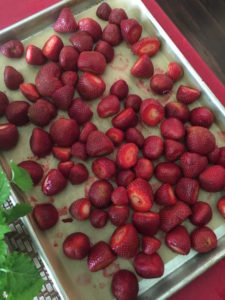

National Strawberry Month
Every year, I look forward to strawberry season so I can stock my pantry and condiment supply with a variety of strawberry jams. Since its National Strawberry month, we wanted to share with you some of the things we like to do with our strawberries and also share a couple of quick tips.
 Strawberry season is short here in Texas so I decided to head back out to my favorite spot to pick strawberries, which is at Good Earth Organic Farm. The strawberries at Good Earth Organic Farm are plump, juicy, and sweet. This was my third year returning to pick some beautiful sun-ripened berries and I was not disappointed. After spending an afternoon picking those yummy red jewels, I am ready to get into the kitchen to make all types of things from jams and vinaigrette to refreshing smoothies.
Strawberry season is short here in Texas so I decided to head back out to my favorite spot to pick strawberries, which is at Good Earth Organic Farm. The strawberries at Good Earth Organic Farm are plump, juicy, and sweet. This was my third year returning to pick some beautiful sun-ripened berries and I was not disappointed. After spending an afternoon picking those yummy red jewels, I am ready to get into the kitchen to make all types of things from jams and vinaigrette to refreshing smoothies.
How to Freeze Strawberries

Herb Pesto
I’ve said before that even if you don’t have a green thumb, growing herbs is easy and fun to do. A sunny kitchen windowsill is a great place to grow herbs if you don’t have garden space. I like to grow basil and thyme in little terra cotta pots in my kitchen since I use these two herbs most and its convenient to have them near when I’m cooking. This year our garden has an abundance of herbs and since people always ask me how to preserve herbs I’ll share some quick and easy ideas and recipes.

 Making pesto is the perfect way to use up those herbs. I love any kind of pesto and having a variety of fresh herbs on hand lets me get creative. You’re probably familiar with basil pesto but did you know that parsley, mint, oregano, cilantro, and oregano can be used to make pesto? Not crazy about pine nuts? Use almonds, walnuts or pecans instead. Here are a couple of simple recipes for adaptable pestos that can be used on grilled fish, chicken, roasted vegetables and steaks. I also like to flavor mashed potatoes and soups with pesto and I’ve been known to dip my french fries in basil pesto too.
Making pesto is the perfect way to use up those herbs. I love any kind of pesto and having a variety of fresh herbs on hand lets me get creative. You’re probably familiar with basil pesto but did you know that parsley, mint, oregano, cilantro, and oregano can be used to make pesto? Not crazy about pine nuts? Use almonds, walnuts or pecans instead. Here are a couple of simple recipes for adaptable pestos that can be used on grilled fish, chicken, roasted vegetables and steaks. I also like to flavor mashed potatoes and soups with pesto and I’ve been known to dip my french fries in basil pesto too.
Herb Pesto

- Fresh Mint Pesto
- 2 cups loosely packed fresh mint leaves
- 1/2 cup grated Parmesan cheese
- 1/3 cup olive oil
- 1/4 cup almonds (toasted)
- 2 garlic cloves
- 1 tbsp lemon juice
- 1 tbsp water
- Salt and pepper to taste
- Fresh Herb Pesto
- 2/3 cup olive oil
- 1/2 cup loosely packed torn basil leaves
- 1/2 cup flat leaf parsley
- 2 tbsp oregano leaves
- 1 tbsp rosemary leaves
- 1/3 cup pine nuts (toasted)
- 1 tbsp lemon juice
- 1 tbsp water
- Salt and pepper to taste
- Process: Add everything to your processor and whirl it around until it has a thick paste-like consistency. I like mine on the chunky side but you may like it smoother. If it’s too thick , add a bit of water.
Pesto can be frozen in ice cube trays and added to other recipes long after herb growing season is over. Just fill ice cube trays, freeze, then pop into a plastic baggy to store in the freezer.


